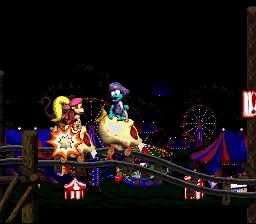Donkey Kong Country 2: Diddy's Kong Quest (Super Nintendo) Second Opinion Review
By Renan Fontes  10.09.2016
10.09.2016

It's not hard to imagine how much of a gamble Nintendo and Rare were both taking when omitting Donkey Kong as a playable character from Donkey Kong Country 2. The sequel to one of the SNES' biggest hits would no longer feature its protagonist in a starring role. Nowadays, DKC2 is regarded as a high point of the Donkey Kong franchise, but, back in 1995, Diddy's Kong Quest was taking a handful of risks to get to where it wanted. No Donkey Kong, more gimmicks, and a ramped up difficulty; Rare's no risk, no reward mindset might have been the key to the success of Donkey Kong Country 2.
Part of what made the original Donkey Kong Country so novel was how strongly it stuck to its setting. DK's island felt like a genuine jungle with geography that made a reasonable amount of sense, and a layout that lent itself to some environmentally natural platforming.
Realising, perhaps for the better, that the jungle setting was utilised to its fullest in DKC1, the sequel instead chooses to get a bit more creative with its level choices. Still refusing to adhere to the world norm that Nintendo had set with Super Mario Bros., Donkey Kong Country 2's stage choices include pirate ships, volcanoes, bee hives, gulches, and dungeon-like towers.

While the stages no longer flow as naturally in one concrete setting, it's not really a flaw. What worked for DKC1 doesn't necessarily mean it'll work for DKC2. Diddy's quest is a different beast entirely than Donkey's banana hoard hunt. There's an emphasis on straying away from safety and playing with ideas that could yield extreme results in either direction.
Diddy and Dixie, themselves, are testaments to Rare's risky design philosophy. Diddy takes on the role Donkey had, being the heavier lead character, albeit faster and more flexible, while Dixie takes on Diddy's role as the lightweight support character. D&D aren't just substitutes for Donkey and Diddy, however; they very much have their own dynamic that affects how stages are played.
While Diddy serves as the Donkey replacement, he still feels how he did in DKC1; quick and nimble, but with a much tighter control this time around. Dixie isn't as fast as Diddy, but she makes up for it with a glide that makes traversing over gaps much easier.

With Diddy and Dixie being a more flexible duo than Donkey and Diddy, the level design naturally has to be accommodated to match that. Stages now feature more precise platforming sections that offer a greater challenge compared to the first game, playing to the strengths and weaknesses of both characters. Levels will simultaneously incorporate sections that are better suited for Diddy's speed, while also adding in wide gaps that are better tackled by Dixie's more forgiving jump.
Animal buddies make a return appearance, as well; this time being given a bit more focus for the sake of level variety. Despite being gimmicky in nature, the animal buddy stages tend to be some of the highlights of DKC2 thanks to the challenge they present. Without levels focused solely on the animal partners and their gimmicks, Donkey Kong Country 2's praise most likely wouldn't have lowered, but, as is, the stages offer a nice change of pace from traditional platforming and makes the main levels all the easier to appreciate.

Aesthetically and musically, DKC2 looks and sounds better than Donkey Kong Country ever did. The graphics are cleaner, slicker, and make more use out of the diorama-like design, while David Wise's score beautifully accompanies the gameplay with a dream-like ambience that only adds to the sequel's already charming personality.
Where Donkey Kong Country 2 really excels over the original, however, is through its side content. Just about every stage has a bonus level to go along with it, but along with these are collectible DK Coins and Kremkoins that offer alternate endings and, in the case of Kremkoins, post-game levels that don't pull any punches in regards to challenging Diddy and Dixie.

Cubed3 Rating
Exceptional - Gold Award

It's precisely because of Donkey Kong Country 2's eccentricities that it manages to succeed as triumphantly as it does. Ditching the Donkey Kong and Diddy Kong duo for Diddy and Dixie is an inspired and brave choice that changes up the gameplay just enough, but not too much, while also giving the sequel a distinct, fresh feel over the original that carries over into the general design of the whole game. It takes risk after risk as a sequel, but it accomplishes each goal with such finesse that it's hard not to love every bizarre, new idea. Sticking close enough to build off on DKC1's weak point and straying far enough to define its own identity, Donkey Kong Country 2 is a gamble that pays off in spades.

![]() 9/10
9/10
![]() 6/10
(34 Votes)
6/10
(34 Votes)
 Out now
Out now  Out now
Out now  Out now
Out now  Out now
Out now Comments
Comments are currently disabled

 Sign In
Sign In Game Details
Game Details Subscribe to this topic
Subscribe to this topic Features
Features





 Top
Top

